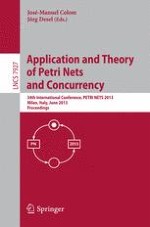2013 | Book
Application and Theory of Petri Nets and Concurrency
34th International Conference, PETRI NETS 2013, Milan, Italy, June 24-28, 2013. Proceedings
Editors: José-Manuel Colom, Jörg Desel
Publisher: Springer Berlin Heidelberg
Book Series : Lecture Notes in Computer Science
